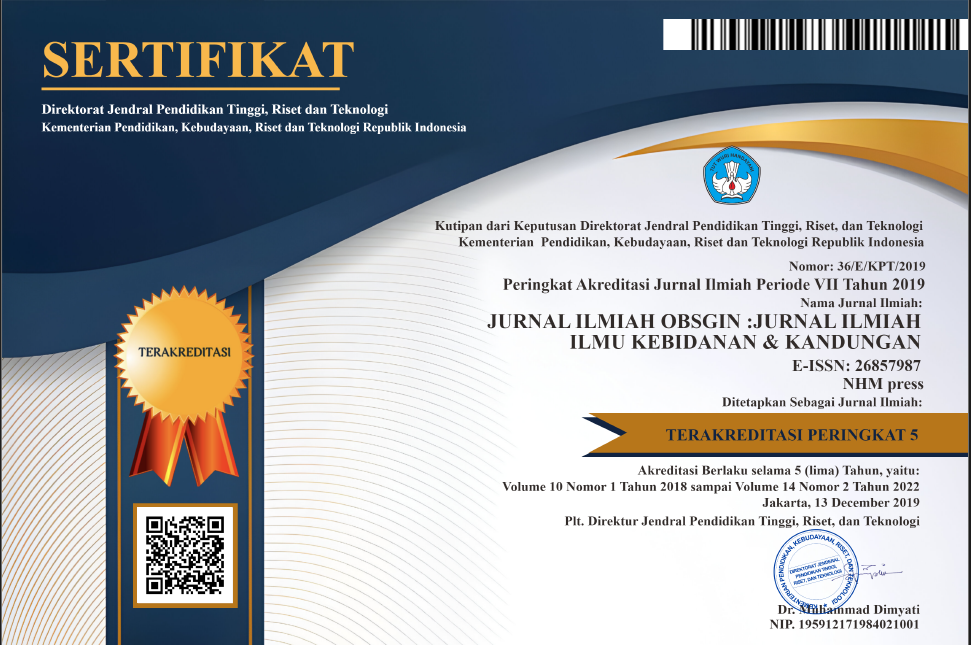MALARIA PREVALENCE RISK FACTORS IN PREGNANT WOMEN IN THE WORK AREA OF KOTARAJA HEALTH CENTER JAYAPURA CITY
Abstract
Pregnant women are the adult age group with the highest risk of contracting malaria. The purpose of this study was to determine the risk factors for the incidence of malaria in pregnant women. This type of research is observational using a case control study design. The population was 522 pregnant women who were positive for malaria and negative for malaria recorded in the health center register in 2013. The sample was 80 pregnant women consisting of 40 pregnant women positive for malaria and 40 pregnant women negative.The results showed that there was no relationship between the habit of going outside at 18.00 - 20.00 with the prevalence of malaria (p value 0.154), there was no relationship between the habit of wearing long clothes outside the home and the prevalence of malaria (p value 1000), there was no relationship between the habit of wearing clothes every day. mosquito repellent while sleeping with malaria prevalence (p value 1000), there is no relationship between the habit of using mosquito nets while sleeping with malaria prevalence (p value 0.115), there is no relationship between the habit of opening windows at night at 18.00 – 20.00 with the prevalence of malaria (p value 0.115). value 0.431), there is a relationship between the presence of wire gauze on ventilation with malaria prevalence (p value 0.000).This study concluded that the variable associated with malaria prevalence was the presence of gauze on ventilation.
References
Dinkes Provinsi Papua. 2013. Profil Kesehatan Provinsi Papua.
dr. Putu A dan Adi P. 2010. Malaria dalam Kehamilan. Jakarta : EGC.
Haqi dan Astuti. 2016. Hubungan antara Faktor Lingkungan dan Perilaku dengan Kejadian Malaria di Wilayah Kerja Puskesmas Sanggeng Kabupaten Manokrawi Papua Barat. Jurnal Kedokteran Kesehatan Vol 12 No 2 (202-213). https://jurnal.umj.ac.id/index.php/JKK/article/view/1565/136
Mofu, Renold M. 2022. Hubungan Kebiasaan Berada di Luar Rumah dengan Kejadian Malaria pada Masyarakat di Kampung Jaifuri Wilayah Kerja Puskesmas Arso 3 Kabupaten Keerom. Jurnal Bidan Prada Vol 13 No 1. Edisi Juni 2022.https://ojs.stikesylpp.ac.id/index.php/JBP/issue/view/40
Mustafa, M., M.Saleh, F., & Djawa, R. (2018). Penggunaan Kelambu Berinsektisida dan Kawat Kasa Dengan Kejadian Malaria di Kelurahan Sangaji. Media Publikasi Promosi Kesehatan Indonesia (MPPKI), 1(3), 93-98. https://doi.org/10.56338/mppki.v1i3.311
Noviarti IP, Joko Tri, Dewanti N. 2016. Hubungan Faktor Lingkungan Fisik Dan Perilaku Penghuni Rumah Dengan Kejadian Penyakit Malaria Di Wilayah Kerja Puskesmas Kokap Ii, Kabupaten Kulon Progo, Daerah Istimewa Yogyakarta. JURNAL KESEHATAN MASYARAKAT (e-Journal) Volume 4, Nomor 1, Januari 2016 (ISSN: 2356-3346) http://ejournal-s1.undip.ac.id/index.php/jkm
Pat Dale., Neil Sipe., et al. 2002. Analysis of environmental risk factors for malaria in the Timor Tengah Selatan District, NusaTenggara Timur Province. Australia: Faculty of Environmental Sciences, Nathan Campus, Griffith University, Queensland.
Rangkuti AF, Sulistiyani, Nur Endah W. 2017. Faktor Lingkungan dan Perilaku yang Berhubungan dengan Kejadian Malaria di Kecamatan Panyabungan Mandailing Natal Sumatera Utara. BALABA Vol.13 No.1, Juni 2017: 1-10. http://doi.org/10.22435/blb.V13i1. 4672. 1-10.
Simon, M. (2021). HUBUNGAN PENGGUNAAN KELAMBU DENGAN KEJADIAN MALARIA DI PUSKESMAS MARIPPI. Nursing Inside Community, 4(1), 25-29. Retrieved from http://jurnal.stikesnh.ac.id/index.php/nic/article/view/837
Sudarianto. 2009. Masalah Kesehatan dan Indeks Pembangunan Manusia. Bandung: Alfabeta.











